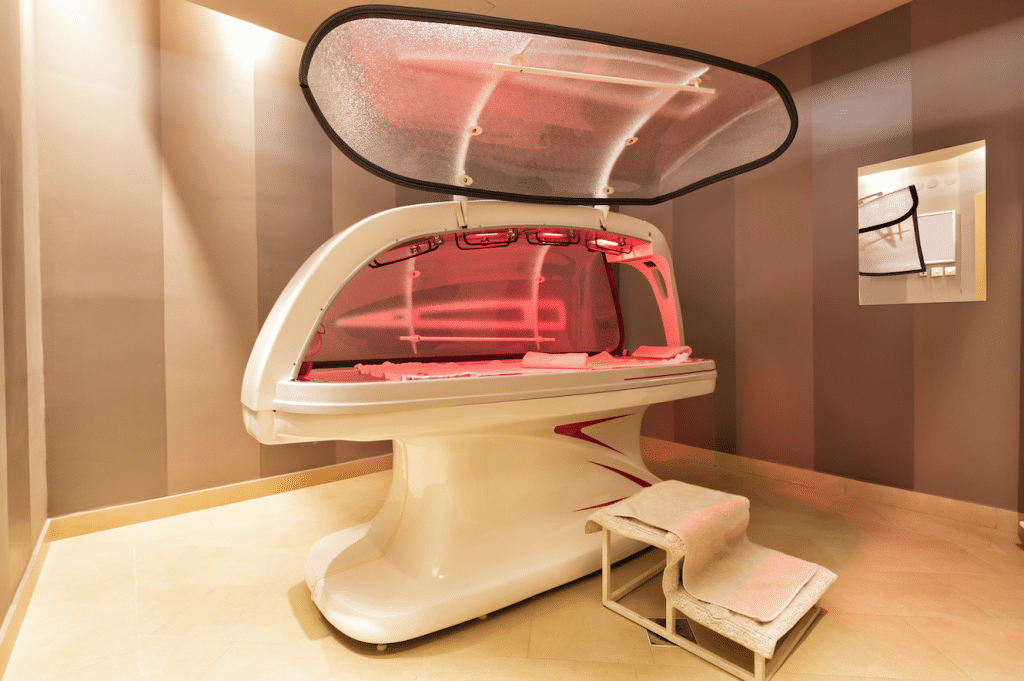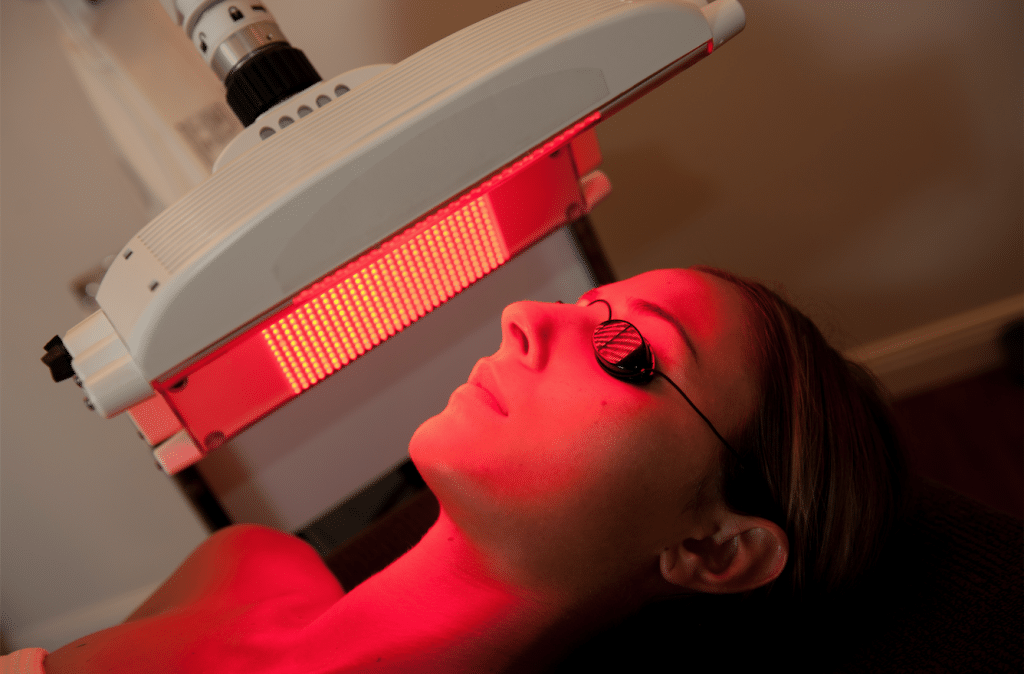
Red Light Therapy has been steadily growing in popularity since the early 1990’s and, believe it or not, was originally developed for NASA plant growth experiments in space 1.
A number of studies have produced evidence suggesting light-emitting diodes (LED) can deliver light to deep tissue, which promotes wound healing and human tissue repair 2.
The Key to Treating Ailments and Achieving Health Goals
RLT is a versatile treatment offering health benefits as diverse as they are impressive. In fact, it could very well be the missing key to achieving your health goals, including fat loss, anti-aging and other wellness-related objectives.
Think about this: what if a simple treatment that harnesses the power of light could replace all those bottles, jars, and tubes in your medicine cabinet that (falsely) promise to help you reach your health goals?
While it’s not currently approved by the FDA and most insurance plans won’t cover it, this light treatment still continues to grow in popularity because it’s a non-invasive health care option and delivers huge value for a reasonable price.
When something is safe, inexpensive and effective, word travels fast.
What Is Red Light Therapy?
Over the course of treatment, light therapy exposes bodily tissues to red and near-infrared light between therapeutic wavelengths of 660 nm and 890 nm, with low-level lasers or red LED lights.
Other names for it include:
- Low-level laser therapy (LLLT)
- Low-level light therapy
- Low-power laser therapy (LPLT)
- Biostimulation (BIOS)
- Photobiomodulation (PBM)
- Soft laser therapy
- Cold laser therapy
- Photonic stimulation or light box therapy
“Bioactive” Light Sources And Why We Need Them
Modern lighting environments lead to a condition called mal-illumination, which has wide-spread effects on everything from our brain and organ function to immune system performance.
Red and near-infrared light have a beneficial effect on our cells, hormones, neurotransmitters and mood. The human body is designed to absorb ample amounts of these types of light for optimal health, and Red Light Therapy treatments are an effective way to do just that.
Most of us only think about light in terms of what things it can do for us to make life more convenient. But what most of us don’t realize is that many different types of light are “bioactive” in humans, meaning they affect the functioning of human cells. Our health is linked to how much and what kinds of light we get every day.
Types Of Bioactive Light
There are five types of bioactive light which affect the human body:
- Blue Light – Sets the circadian rhythm in our brain, which in turn affects neurotransmitters and hormone levels.
- UV Light – Allows us to synthesize vitamin D from sunlight.
- Far-Infrared – Acts to heat up our cells which stimulates changes in cell function as well as circulation changes. This is the sun’s spectrum responsible for feeling heat when you walk outside on a sunny day.
- Red Light – Acts on the mitochondria in our cells to stimulate increased cellular energy (ATP) production.
- Near-Infrared (NIR) – Also acts on the mitochondria in our cells to stimulate increased cellular energy (ATP) production.
NIR and red light are different from daylight. Unlike rays from the sun which damage skin cell DNA, light emitted within this spectrum is perfectly safe.

Health Consequences of Mal-illumination
Most people are deficient in the benefits of all five of these light wavelengths. What does that mean in practical terms? There are two well known examples of light deficiencies and imbalances: sunlight and vitamin D. Each of these is linked with numerous conditions including:
- Neurodegenerative diseases (like Alzheimer’s dementia, Multiple Sclerosis and Parkinson’s)
- Certain types of cancer (over a dozen different kinds)
- Obesity and fat gain
- Diabetes and metabolic syndrome
- Metabolic syndrome
- Heart Disease
- Depression and mood disorders
- Insomnia and poor sleep
Near-infrared (NIR) and red light deficiencies are specifically linked to widespread effects on our brain, organ function, immune system, energy levels, mood, neurotransmitter balance and hormone levels 3.
Some research even suggests that inadequate levels of sunlight exposure increase risk factors for human health equivalent to that of smoking cigarettes.
Another study looked at 30,000 women over a 20 year period and found that women with the lowest sun exposure had a twofold higher rate of death as compared to women with the most sun exposure 4.
Does It Really Work?
Red and NIR therapy has been studied and tested repeatedly across hundreds of peer-reviewed clinical trials, with positive results in a widespread number of ways including:
-
- Overall skin health
- Increased collagen production
- Improved physical performance
- Faster muscle recovery
- Optimal sleep duration
- Joint & chronic pain relief
- Reduced inflammation
- Enhanced weight loss
And all without drugs, chemicals, harmful UV rays, invasive procedures or negative side effects.
How Does Red Light Therapy Produce All These Benefits?
Because this type of therapy only produces beneficial results within a narrow band of red and near infrared wavelengths, not just any light source will do. Optimal health results are only achieved using safe, scientifically proven methods.
For the sake of clarity and brevity, we’ll cover in broad terms two key mechanisms which make Red Light Therapy or Photobiomodulation so effective:
- ATP production stimulation; and
- Hormesis
1) ATP Production Stimulation
It stimulates ATP production in a cell’s mitochondria by interacting with a photoreceptor called cytochrome c oxidase. RLT increases mitochondrial energy production, which has highly beneficial health ramifications 5.
The Details
NIR and RLT wavelengths are able to penetrate cell lining to activate mitochondria, increasing cellular energy production capacity.
And, as the preponderance of scientific evidence bears out, mitochondria are integral to health, disease prevention, energy levels and longevity. In simple terms, they are the batteries that fuel all the processes of our organs.
So anything that enhances the mitochondria’s ability to produce cellular energy optimizes organ function and boosts brain, heart, liver, skin and muscle performance.
Since cytochrome c oxidase drives the respiratory chain in mitochondria responsible for producing cellular energy (ATP), when red and NIR light photons hit this photo receptor, it allows mitochondria to use oxygen more efficiently, which in turn increases ATP levels.
The Role Of Nitric Oxide In ATP Production
Most researchers believe that nitric oxide (NO) plays a central role in how effectively mitochondria generate cellular energy.
Though NO is necessary to healthy function, too much nitric oxide in the wrong place can be detrimental, and certainly when cells don’t have the antioxidant capacity to neutralize unhealthy levels of NO, ATP production is hindered in the mitochondria.
This is because at higher levels, NO begins to compete with oxygen in the mitochondria, blocking the cytochrome c photoacceptor from binding with sufficient oxygen, which— again in very simple terms — inhibits the amount of cellular energy the mitochondria is able to produce.
Red and near-infrared light essentially prevents cytochrome c oxidase from pairing with NO (often to the exclusion of oxygen molecules, which inhibits ATP), thereby allowing cytochrome c oxidase to pair with oxygen instead, which optimizes ATP production.
In this way, NIR and RLT can boost the mitochondrial function for the increased production of ATP, thereby improving the health of every organ and system in the body.
2) Hormesis
Hormesis is the process by which a transient metabolic stressor stimulates adaptations that actually improve health.
Red light and NIR therapy are a form of hormesis, helping make your cells more tolerant to stress. Additionally, these treatments reduce the buildup of free radicals, making you healthier, more energetic and more resilient.
Using physical exercise to illustrate this concept, a demanding workout stresses the body’s muscles (temporarily increasing reactive oxygen species or free radicals), and triggers a response to that stress, with the body ultimately adapting to these conditions, resulting in things like improved cardiovascular efficiency and blood delivery to the stressed muscles.
In the same way, red light and NIR treatments produce transient increases in free radicals, activating many of the same anti-oxidant and anti-inflammatory defense systems as when muscles are stressed during a heavy workout.
Red and near-infrared light waves stress mitochondria causing them to send signals to the nucleus of the cell, “telling” DNA within that nucleus which genes should be expressed.
This “retrograde signaling” essentially means that just as genes affect what happens in our cells, so do external stressors affect which genes are switched on and off.
Unlike a temporary fix that may treat a symptom, red/NIR light stimulates your body to heal itself, making lasting adaptations at the cellular level that lead to resilience against stressors and a greater capacity to produce energy.
How Does Red Light Therapy Work On Skin?
Red light stimulates collagen production as well as elastin production, and can reduce the appearance of:
- Fine lines and wrinkles
- Appearance of scars
- Surface varicose veins
- Skin conditions like rosacea
- Acne
- Cellulite
A 2013 issue of Seminars in Cutaneous Medicine and Surgery featured a review of the research that highlighted dozens of studies proving photobiomodulation can reduce the signs of aging.
Light therapy is commonly used to target oil glands to reduce cytokines, which cause inflammation and play a role in chronic acne.
LED Light Therapy
Repairing damage from UV rays requires that skin repair cellular and DNA damage, much as it does when healing wounds.
Light Emitting Diode (LED) therapy works by emitting infrared light wavelengths at therapeutic levels.
But not all wavelengths are equal (nor all devices). You should know which power density is best for treating which conditions. When you’re attempting to resolve a specific problem, wavelength and intensity make all the difference between incredible benefits and no benefits.
Are There Any Side Effects?
According to a peer-reviewed NCBI article published recently, there is “an almost complete absence of side effects” associated with red light therapy 6.
That said, anecdotal accounts suggest some people may find it to be irritating or bothersome to the eyes, though this side effect is easily remedied by wearing tanning bed goggles.
With its seemingly never ending health benefits and safeness, it is no wonder that Dr. Michael Hamblin is also an advocate You can hear our full podcast interview here : The science on Red Light Therapy Benefits.“
Where Can You Get It?
Red light therapy devices can be found in some salons, and there are a number of reputable manufacturers of at-home devices currently on the market; sizes range from small (e.g. LED masks), to medium and large (which can look like tanning beds). Always consult a medical professional prior to use.
Now that you understand how red light therapy works, you can get even more information on the science behind its effectiveness, health benefits, tips to get the best results, and MORE by clicking here.
References[+]
| ↑1 | Whelan, HT, et al. (2001). Effect of NASA light-emitting diode irradiation on wound healing. J Clin Laser Med Surg. 2001 Dec;19(6):305-14. |
|---|---|
| ↑2 | Low level laser therapy (LLLT) / photobiomodulation (PBM) / red/NIR phototherapy studies – a comprehensive database. |
| ↑3 | Taylor, M, (2018). Why Light is Essential for Great Sleep and Optimum Health: An Interview with Ken Ceder. 2018 Aug 9. |
| ↑4 | Whitten, A, (2018). THE ULTIMATE GUIDE TO RED LIGHT THERAPY AND NEAR-INFRARED LIGHT THERAPY (UPDATED 2018). |
| ↑5 | Schaumburg, I, (2011). Colored light sources lighting the way for new office- and home-based skin devices. 2011 Mar 15. |
| ↑6 | Avci, Pinar, et al. (2014). Low-level laser (light) therapy (LLLT) in skin: stimulating, healing, restoring. Semin Cutan Med Surg. 2013 Mar; 32(1): 41–52. |




